In April 2023 I was honoured to be part of a small group of arboriculturists on a study tour to Ukraine.
Our organiser and leader was Piotr Tyszko-Chmielowiec, the President of the Board of the Tree Institute in Poland and someone who has a strong connection with Ukraine. Also from Poland was Aleksandra Zienkiewicz, who works for the Green Spaces Management Board in Wrocław and is a former urban tree activist. From Lithuania we were joined by Renaldas Žilinskas and Kristina Žalnierukynaite, two arborists who also specialise in conducting training for tree workers. The purpose of the journey was to learn about arboriculture in the country, to share ideas and experiences and to show solidarity and support with those who care for trees there.
In the early hours of Sunday 2nd April I arrived in Rzeszów, in south-eastern Poland, to meet up with my Polish and Lithuanian colleagues before heading over the border. The train was surprisingly busy with families travelling home for Easter, and whilst all five of us in the tour group were a little apprehensive about what the next few days would hold, there was also a sense of excitement. A packed schedule of presentations, training, meetings and visits awaited us, all carefully planned and orchestrated by Piotr. We crossed the Ukrainian border without any difficulty and arrived in Lviv to be greeted by Oleksandra Sladkova, Head of Ecology at Lviv city municipality and our host for this first part of the tour.
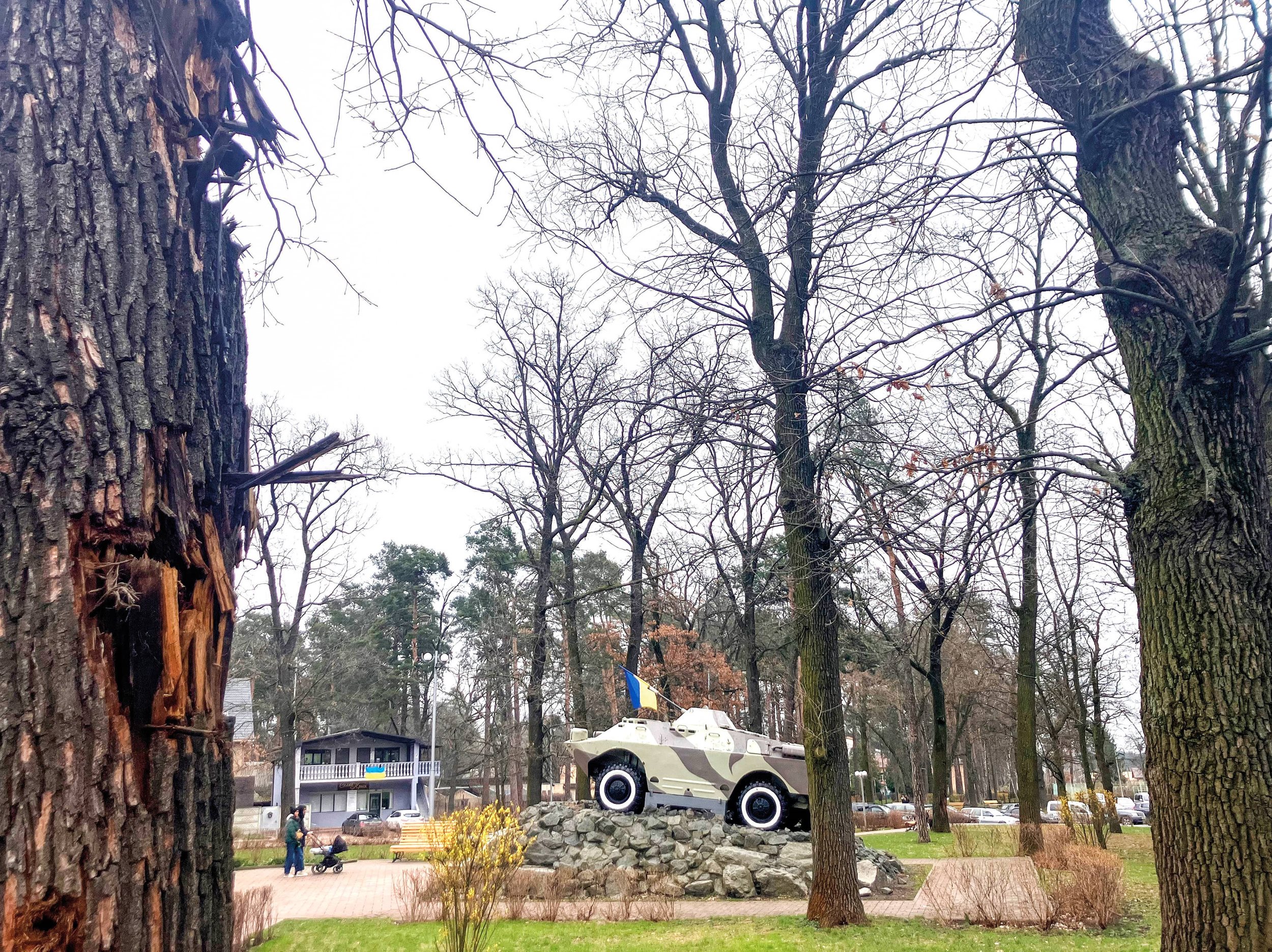
War damage to trees in Bucha.
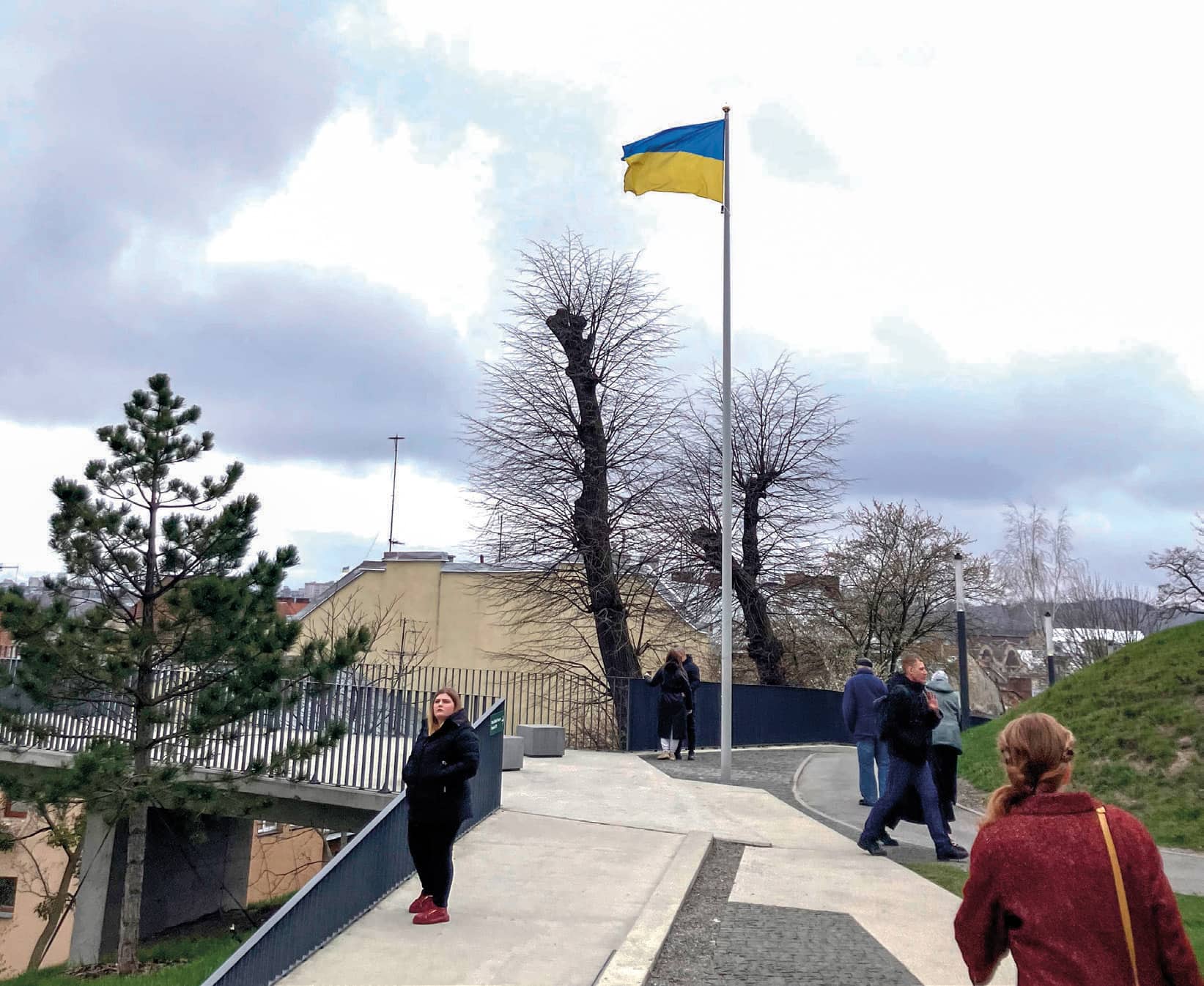
Part of the Memorial of the 100 Heavenly Heroes, Lviv.
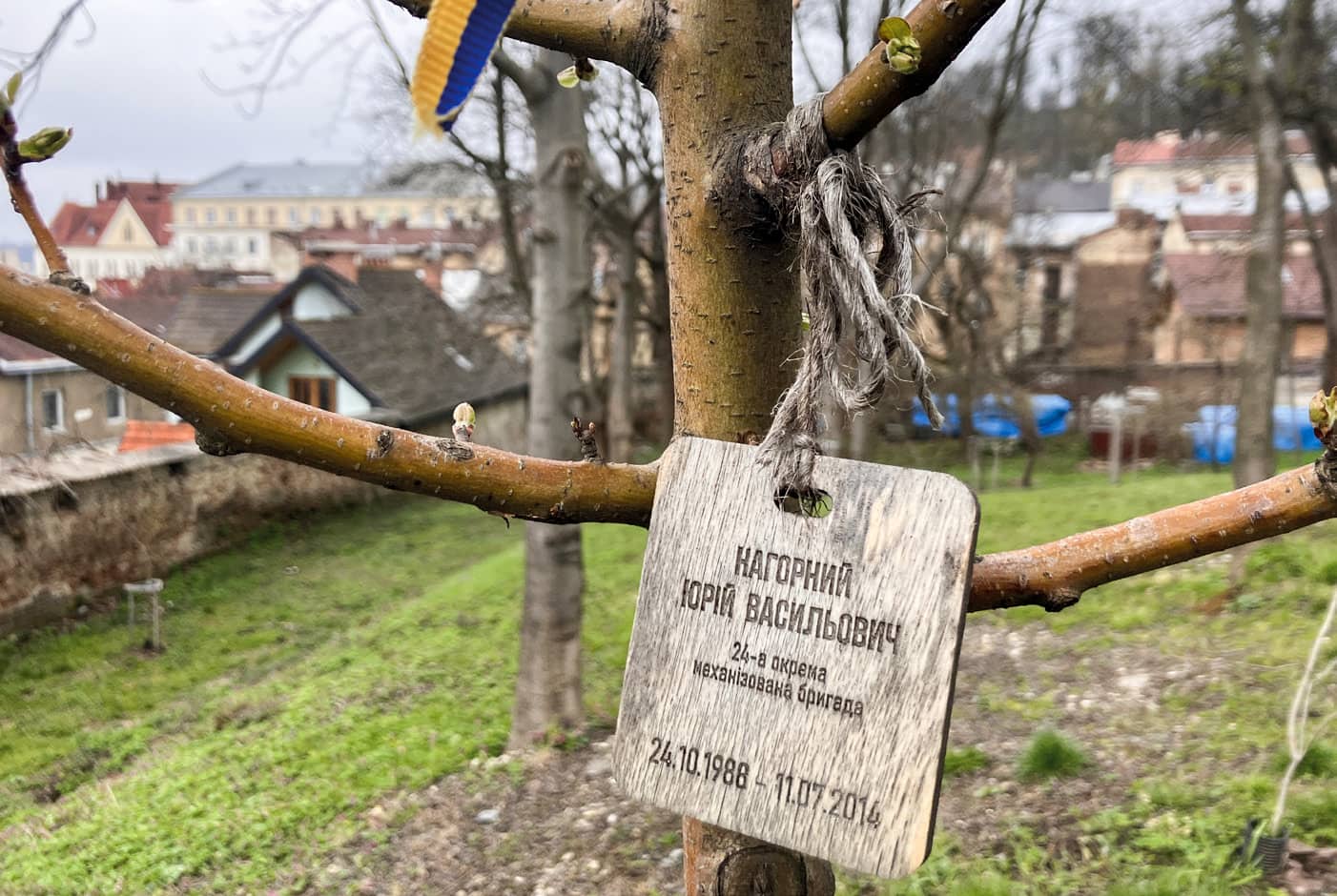
Memorial trees at the Memorial of the 100 Heavenly Heroes, Lviv.
Lviv
Oleksandra led us on a walk around some of the parks and open spaces of Lviv, pointing out many items of interest. One thing we all noticed quickly was the huge number of mature trees which had been topped, which Oleksandra said used to be very common practice until she banned it on public trees in the city. Most of the topped trees seemed to be struggling, and a lot were being completely overtaken by mistletoe.
We visited the Park of 100 Heavenly Heroes, a dynamic and engaging memorial full of new trees, many of which have been dedicated to individuals who lost their lives during the Maidan Uprising in 2014. The public spaces and streets of Lviv are largely dominated by horse chestnut, oak, ash and lime, although Oleksandra and her colleagues have been working hard to encourage more diversity in planting. We saw plenty of good examples of new trees, which are produced domestically in Ukrainian nurseries.
Monday was the first day of our presentation schedule, and after breakfast we walked to our venue. This was America House, where at least 50 people who either work with, or have an interest in, green spaces and trees had assembled for the event. My presentation was first, on the rather generic theme of ‘tree management in the UK’, with the assistance of some excellent simultaneous translators. Then Aleksandra spoke about community engagement in Wrocław, relating specifically to the management of grass and how the municipality is starting to reduce the frequency of mowing in order to encourage biodiversity. Renaldas presented about best practice in tree pruning and the new European standards, and Piotr then gave a talk in Ukrainian about the care of ancient trees. The audience was very engaged and asked plenty of questions after the presentations, during the breaks and at the panel session which was arranged later.
After lunch we had another walking tour, mainly around Ivan Franco park in the centre of the city. We saw some more examples of new and diverse tree planting, and at the other end of the arboricultural life cycle it was encouraging to see the retention of fallen trees, where only recently they would have been removed in the interests of tidying up the landscape. Oleksandra and her team have been doing some really impressive work here, to the benefit of trees and people.
Lviv is a very pleasant city, and watching the red squirrels chasing each other through the treetops in the snow, it was easy to forget that the war is still raging in Ukraine. There were only occasional reminders. The fragile windows of the 14th-century Cathedral Basilica of the Assumption have been boarded up, and the statues outside wrapped in protective material. A poster in America House depicted a line of refugees on the road, watched over by soldiers, with the legend 45,000 MARIUPOL RESIDENTS WERE FORCIBLY DEPORTED. News reached us that a rocket strike in eastern Ukraine had killed six, but sitting in a bar in Lviv enjoying a Ukrainian cider, the deaths seemed as remote as they did when I was at home in the UK.
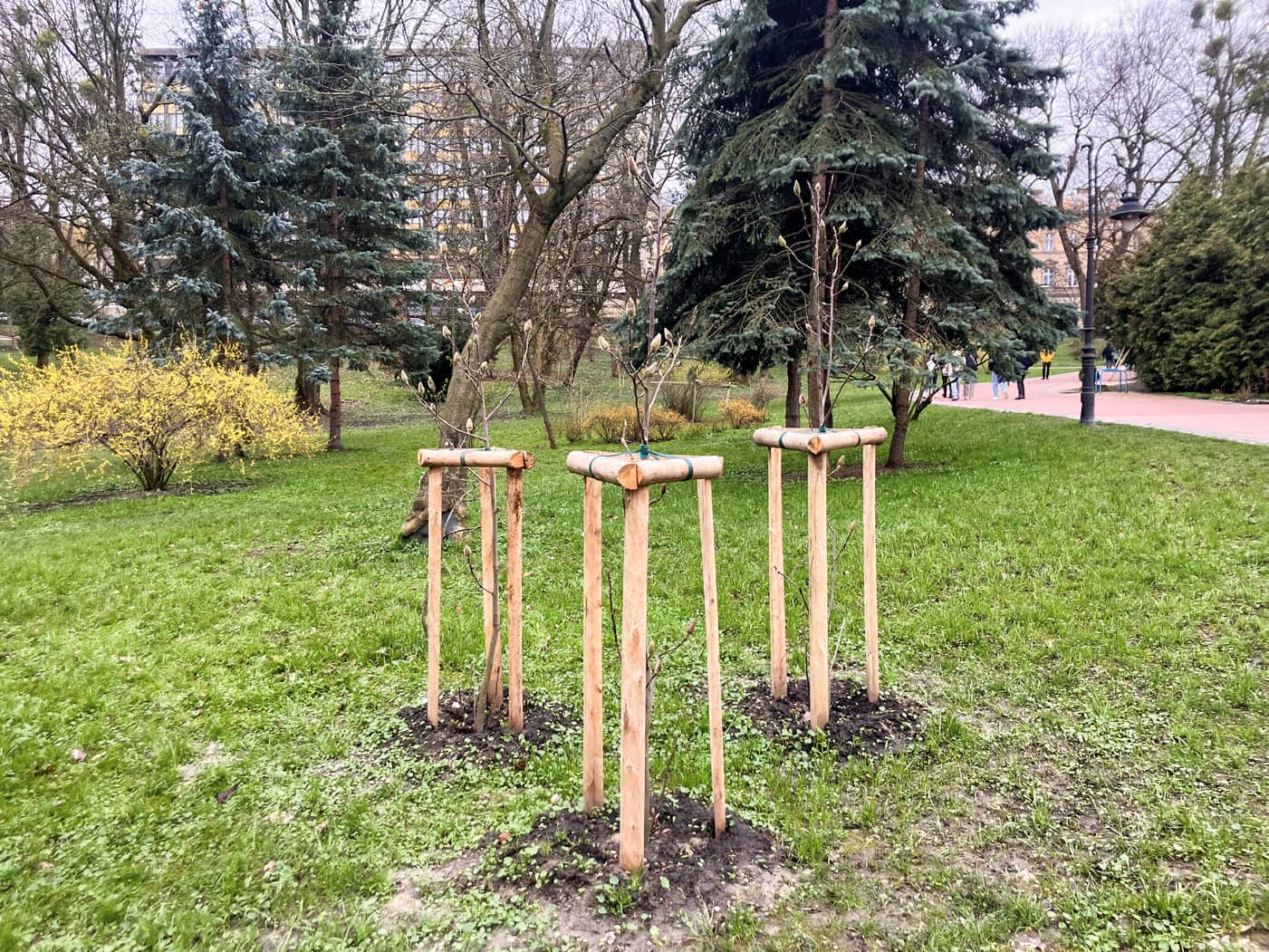
New tree planting at Ivan Franko Park, Lviv.
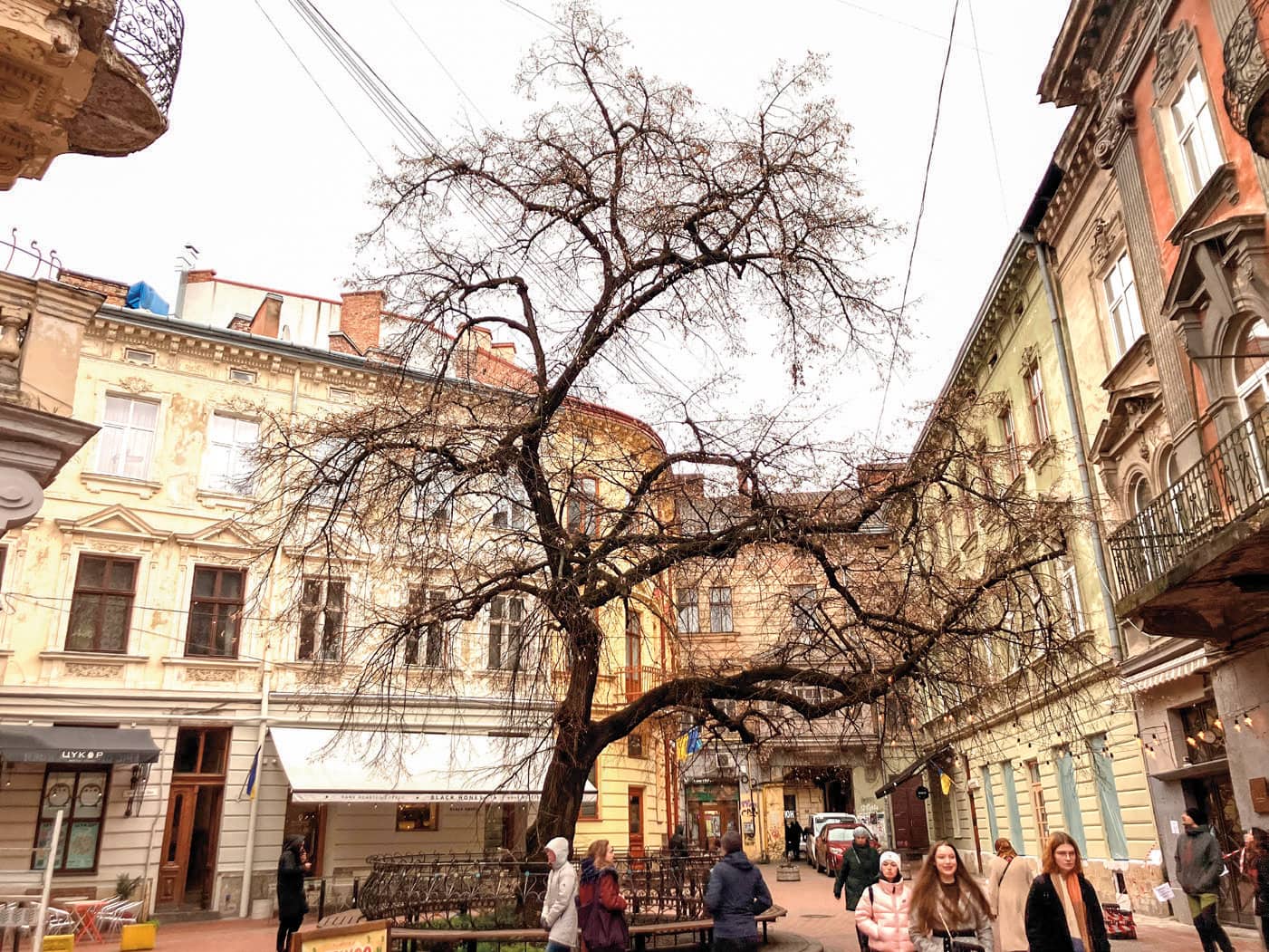
Lime tree in a square in Lviv.
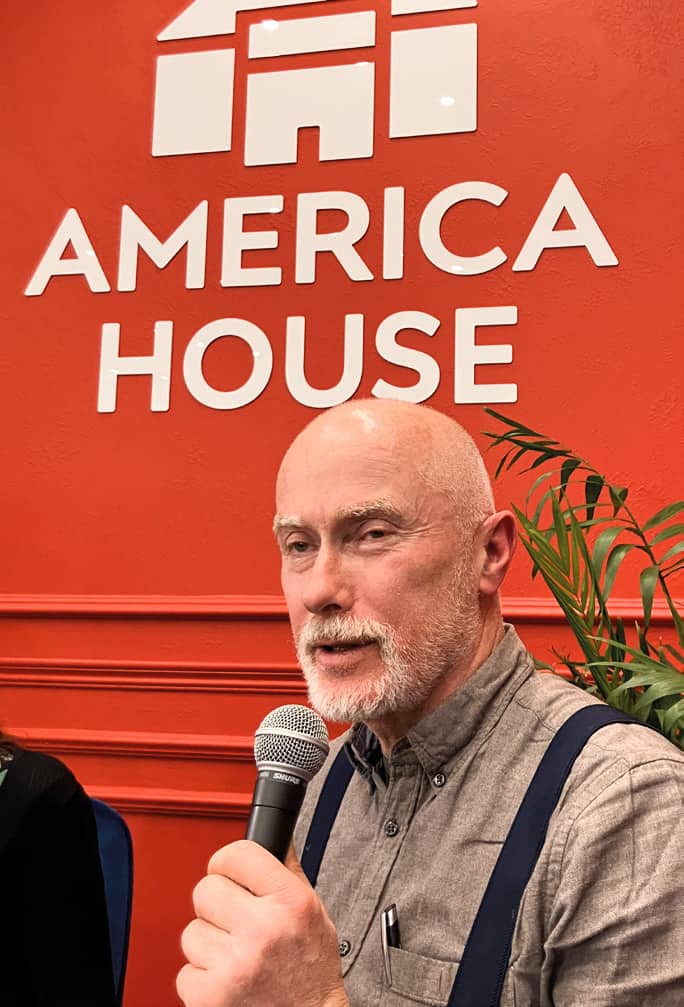
Piotr Tyszko-Chmielowiec presenting at America House, Lviv.
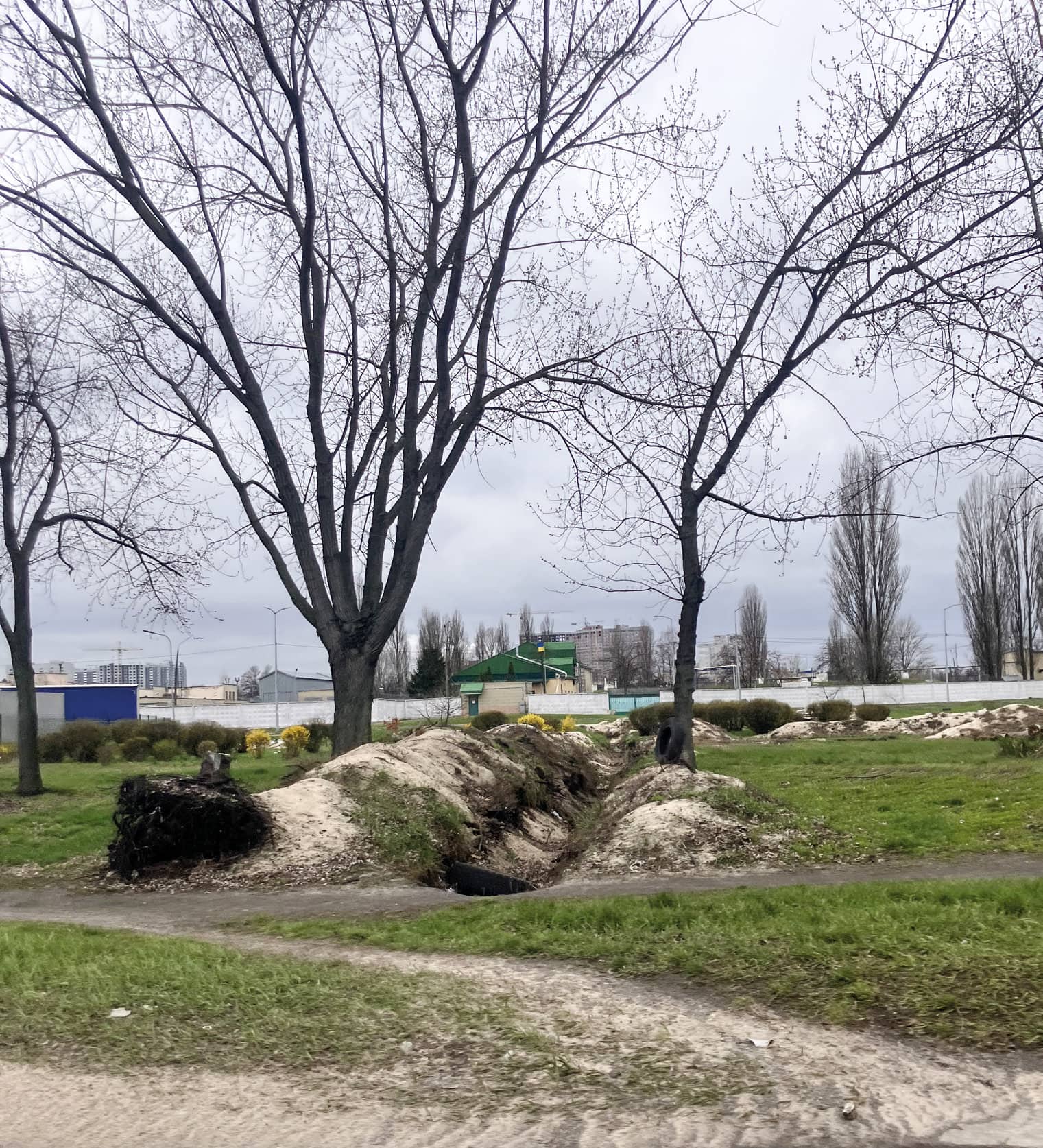
Defensive trenches in the root protection area, Kyiv.
Kyiv
We said our goodbyes to Oleksandra and caught the 23.00 out of Lviv railway station, heading east. It was a proper soviet sleeper train, complete with a carriage attendant armed with a birch-twig sweeping brush and an ever-boiling samovar from which tea or thick black coffee was dispensed to travellers requiring refreshment.
Our own compartment opted to share a bottle of homemade Lithuanian strawberry wine, and after a surprisingly good sleep during the 11-hour journey we disembarked on Tuesday in Kyiv station. Here we were greeted by Yana Bobrova and Anna Oblomei from Peli can live and Olha Pokhylchenko, senior scientist in the dendrology department of the Mykola Hryshko National Botanical Garden. Upon arrival it was obvious that the atmosphere in Kyiv was very different to that of Lviv, with heavy security checks for those trying to board trains, and missile-scarred buildings immediately noticeable as we left the station building.
After breakfast we visited the O.V. Fomin Botanical Garden, where we met with Head of Dendrology Zinaida Bondu and Volodymyr Vetrogradskyi to look at some work where cavities in veteran trees had been cleaned, treated and filled with a polymer, much to the consternation of our tour group. We then went to visit Irpin, in the Kyiv suburbs, where a year ago the Ukrainian defenders blew up one of the main bridges into the town to halt the enemy advance. Here, we were left in no doubt whatsoever that we were in a country at war. Reconstruction is under way and the skeleton of the replacement bridge is in place, but as we surveyed the wreckage of the old crossing we received news that in central Kyiv, just a few miles away, the air raid sirens were sounding.
From Irpin, we were taken to Bucha. This is not the place to write about the atrocities that took place there in March 2022, and I don’t have the words to adequately describe it anyway. But you should perhaps look it up yourself, and learn about the reality of this invasion for many ordinary Ukrainian people. In the central square we assessed the bullet and bomb damage which many of the trees there have suffered. We were given a tour of Bucha Park by Victor Galuschak, Head of the Bucha Municipal Green Service which is responsible for the gardens. He and his team are doing a fantastic job there and it was a real honour to be able to visit the park in his company.
Our next stop was the Mykola Hryshko National Botanical Garden. Yana gave us a brief presentation about the Semen Oblomei Foundation, set up in memory of a young Ukrainian man who wanted to become an arborist but was killed in the invasion at the age of just 22. The Foundation has been created to bring arboricultural training to Ukraine, and to give young people there an opportunity to become professional arboriculturists. You can read more about this inspirational project in an article by Yana on page 30. The charity also has a website, which unfortunately at the time of writing is offline as a result of a widespread cyber-attack on Ukrainian servers, thought to be another front in the ongoing war.
We had been informed that emerald ash borer had reached Kyiv and had asked to be shown some affected trees. We were taken to see a couple of ash in the botanical garden which undoubtedly were not in great shape, and a series of round holes about 2 mm in diameter could be seen on the stems. I am not able to say with certainty whether or not this definitely was emerald ash borer, but by all accounts the insect is indeed gradually moving west across Europe. On a more hopeful note, also in the botanical garden we visited Semen Oblomei’s ginkgo tree, grown by him from seed and now planted in his memory.
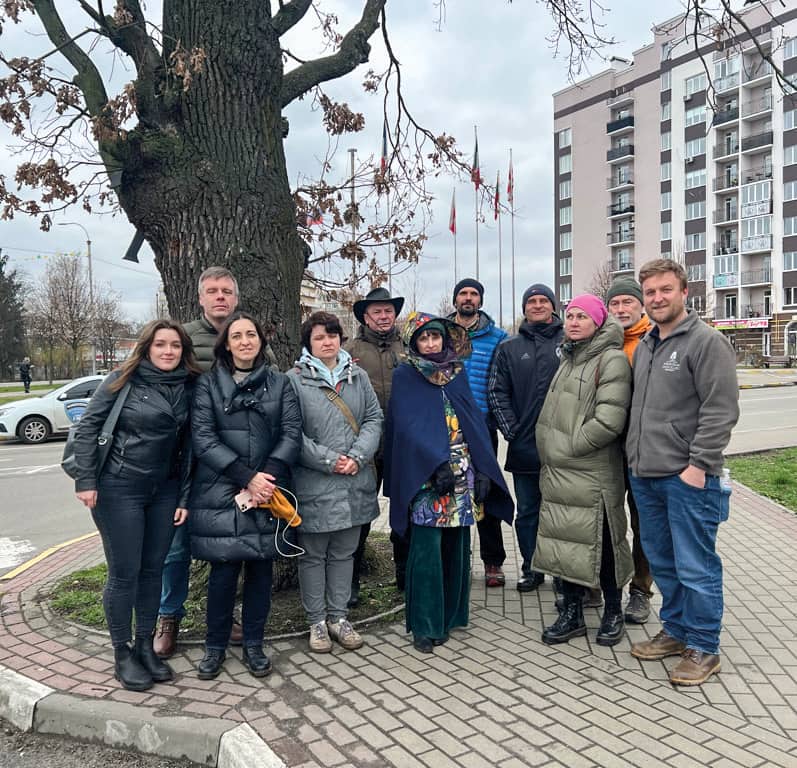
A group photo in Bucha.
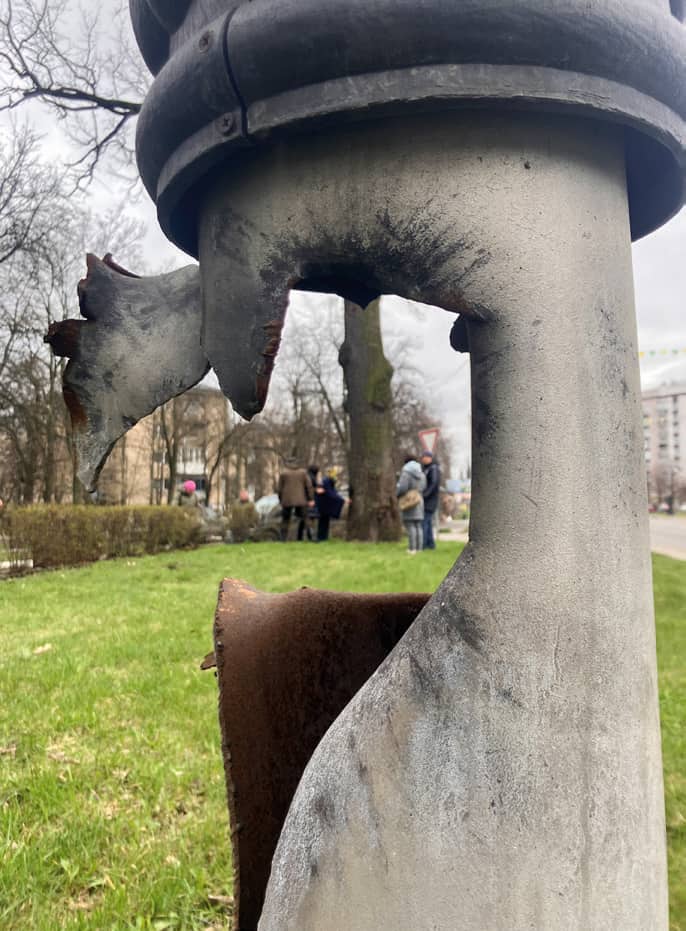
Inspecting damaged trees in Bucha.
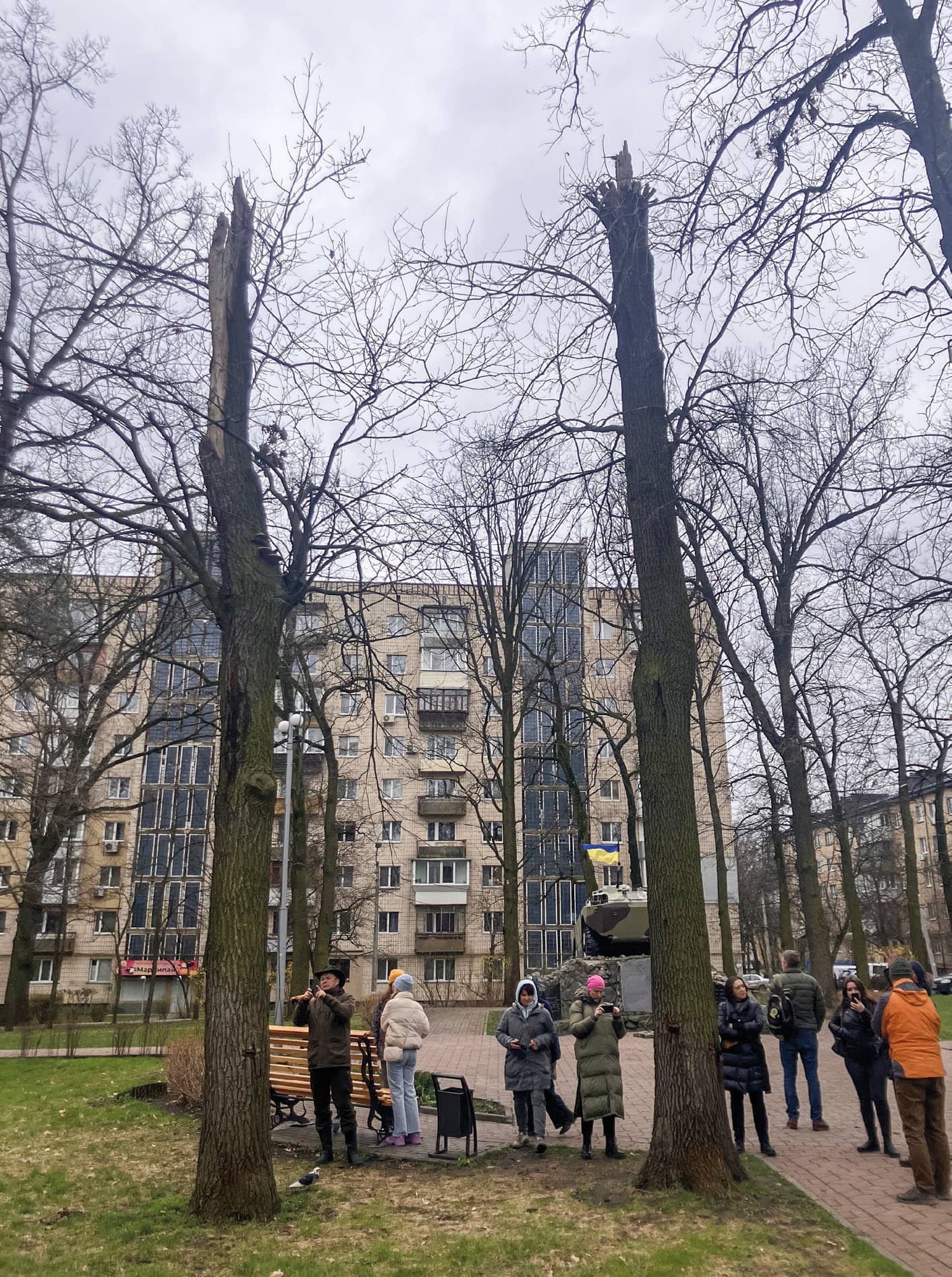
Damage to some of the trees in Bucha.
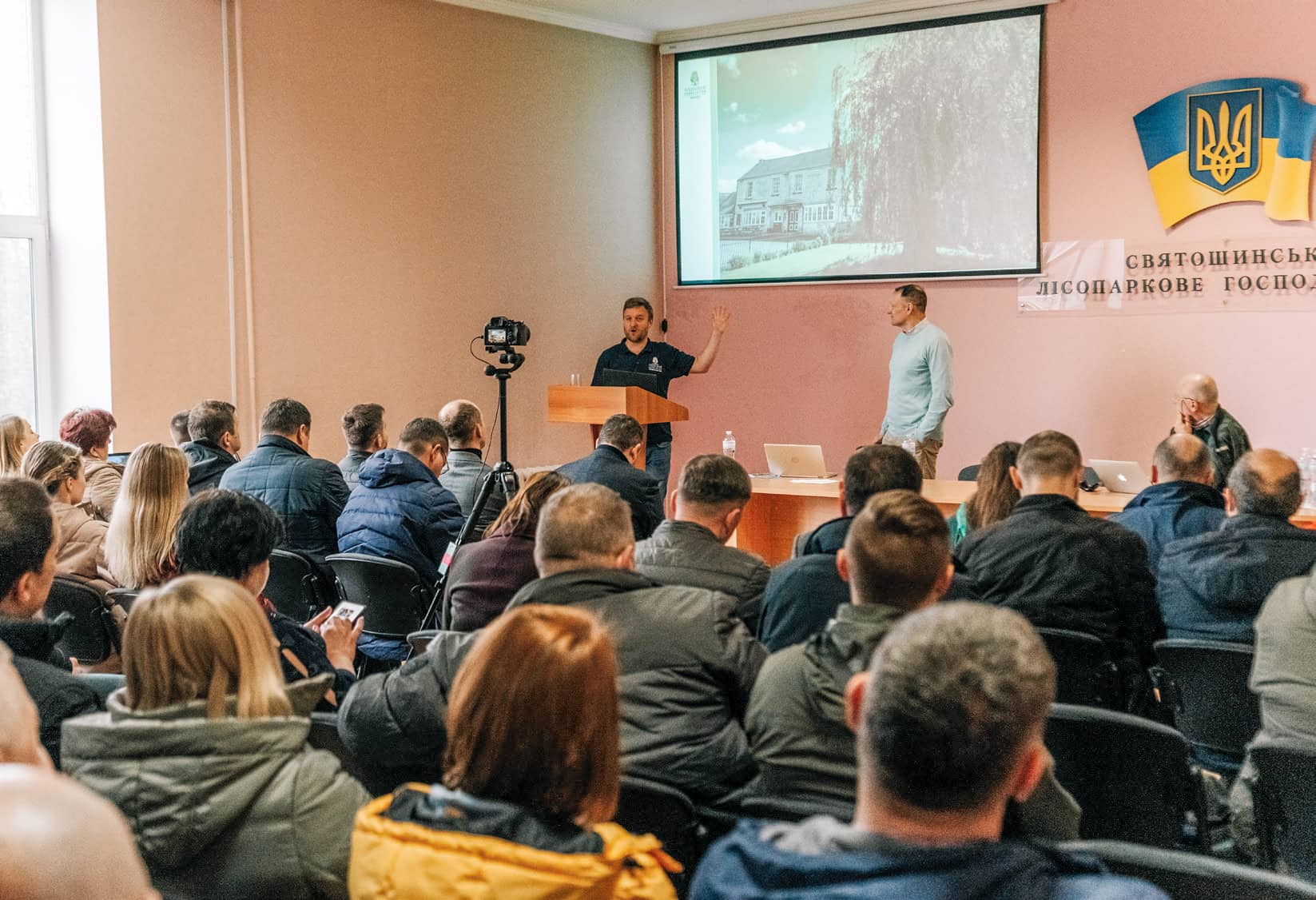
John Parker presenting in Kyiv.
Supporting arboriculture in Ukraine
After our walk we went straight into a meeting to discuss how an arboricultural profession might be created in Ukraine. Part of our own contribution is to start translating Arboricultural Association publications – we have already produced a Ukrainian version of the What is arboriculture? leaflet and we hope to look at making a start on translating the Technical Guides soon. Thanks to the efforts of Piotr, Oleksandra and Olha, the European and Polish standards for pruning are also being translated into Ukrainian. Most of the information needed already exists – it just needs to be made accessible. The meeting was really positive, and we left it feeling that the future for arboriculture in Ukraine is bright.
With a strict curfew in place in Kyiv there is little option but to have an early night – probably a good thing, as on Wednesday I had to give two presentations. This time our venue was the Svyatoshyn Department of Green Management Department of Kyiv City Council, with around 60–70 people in attendance. Delegates were welcomed on behalf of the city of Kyiv by Oleksandr Vozny, Head of the Ecology Department of Kyiv City Council, and our group proceeded to deliver a similar set of talks to those we gave in Lviv. In the afternoon Piotr, Renaldas and I each spoke specifically about the management of ancient trees, and I was also happy to be able to talk a little bit about my home town and the Stonehouse Community Arboretum project.
In both Lviv and Kyiv it was great to have the opportunity to speak to such engaged audiences of interested people who were so keen to build their knowledge of arboriculture. In Kyiv we had the benefit of a few days of experience in Ukraine to refer to, so we were able to go into more detail about particular aspects such as the importance of properly caring for ancient trees, why cleaning and filling cavities is not to be recommended and the dangers of topping. In some very pleasing news, just a couple of weeks after returning from Ukraine, we were delighted to hear that – partly as a result of our visit – the Kyiv City Council Environmental Committee has approved new rules for tree care, including a maximum limit for crown reductions of 35%.
After the seminar we had some rare free time, a welcome development in a week where there had been barely any opportunity to actually process what we had seen and heard. I took the chance to walk down to Maidan Nezalezhnosti, Independence Square, where a sea of Ukrainian flags in the grass mark the deaths of civilians in the conflict. It is a reminder, were another one needed, about the impact this war has had on the lives of the people. Almost everyone we spoke to has been affected, with many having either lost someone in the fighting, or with a friend or family member on the front line. In Mykhailivska Square, in the shadow of St Michael’s Golden-Domed Monastery, is a moving photographic exhibition comparing the damage inflicted on Mariupol in 2022 with what happened in Warsaw in 1939. What at first looked like a modern art sculpture of a termite mound turned out to be the Princess Olga Monument, encased in sandbags. In the centre of the square lies the wreckage of a number of enemy tanks which were destroyed during the battle of Kyiv last year. Affixed to each of these killing machines is a laminated sign – WARNING SHARP EDGES DANGER! Quite right, those things could really do you a mischief if you’re not careful.
Thursday was our last day in Kyiv. After morning presentations from Piotr and Renaldas the plan was for us to lead on some practical tree inspection workshops. Unfortunately, the weather had other ideas and torrential rain meant that it was impossible to do anything meaningful. This was particularly frustrating as the delegates were so keen to learn about tree assessment. About 30 of us took shelter under the awning of a coffee shop, soaked through. In the end we did venture out to watch Piotr leading a brief session, but it was just too wet all morning. In the afternoon things had dried out a bit so we took in some more sights in Kyiv, including seeing some birch trees which had been tapped for sap, with metal tubes extending out of the stem into plastic bottles in which to collect the precious liquid. In the evening Piotr and Aleksandra addressed a meeting of activists, and after a final drink with our hosts we were off to Kyiv station and the sleeper train back to Lviv, reflecting on an intense few days.
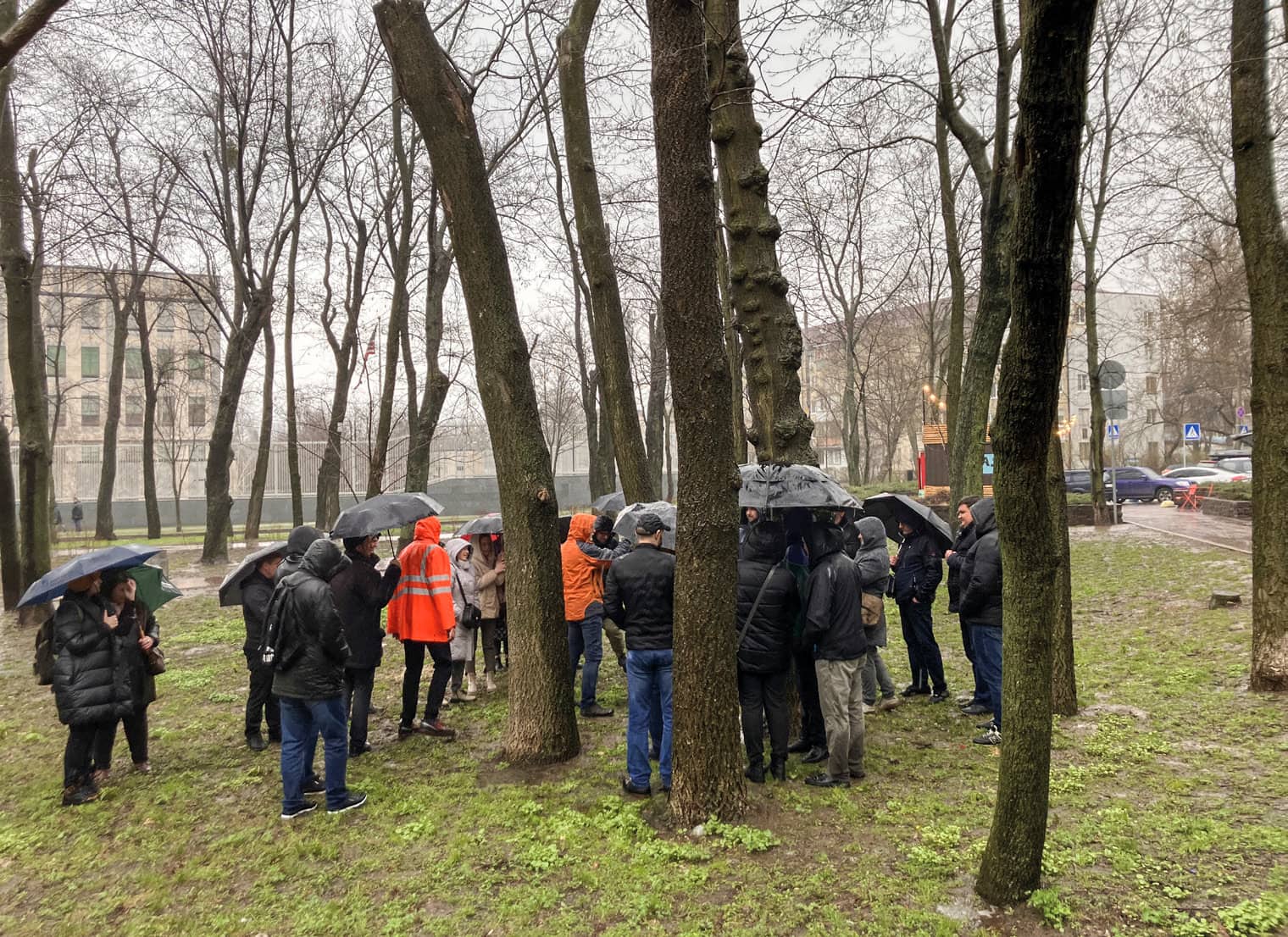
Teaching tree inspection in a downpour, Kyiv.
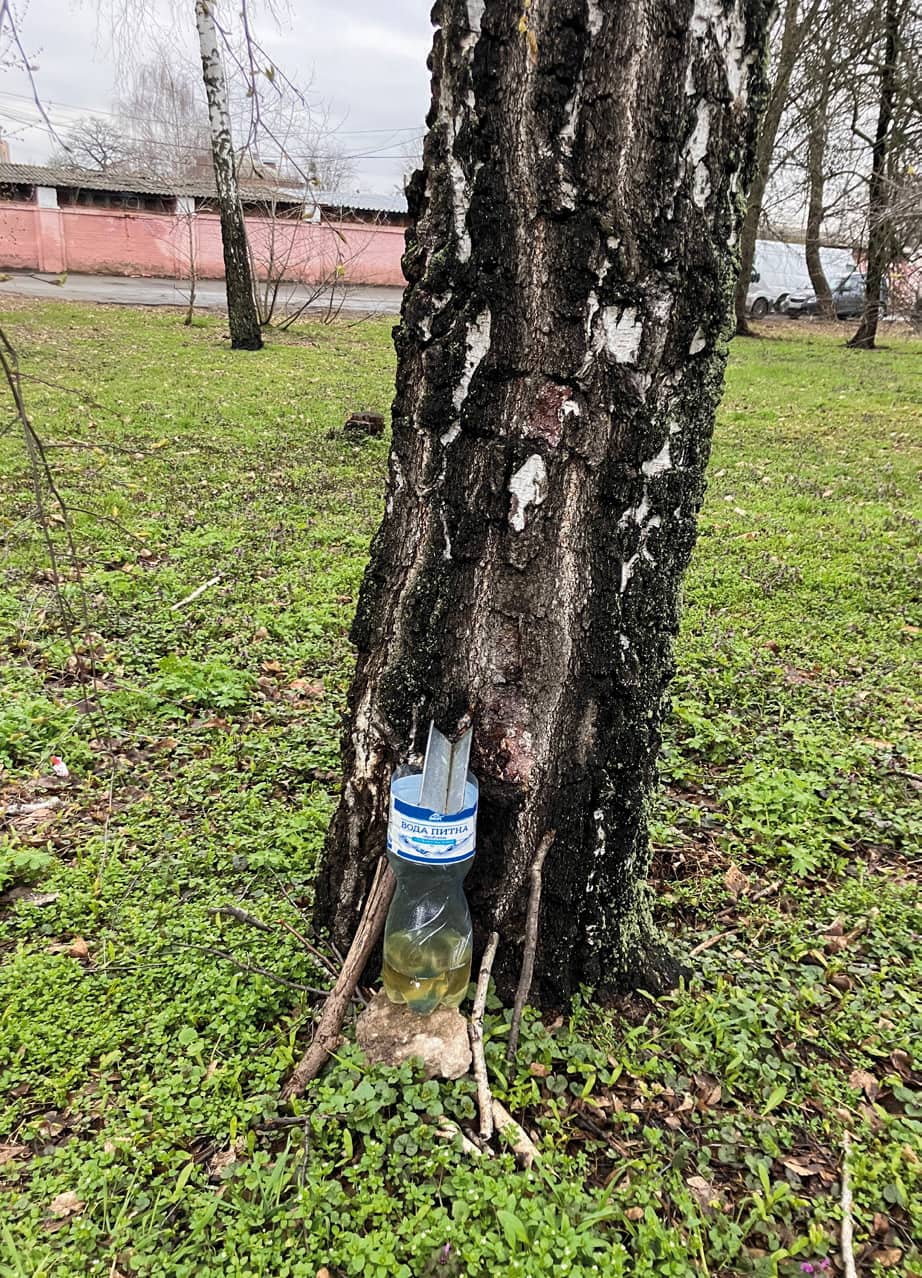
Birch tapping, Kyiv.
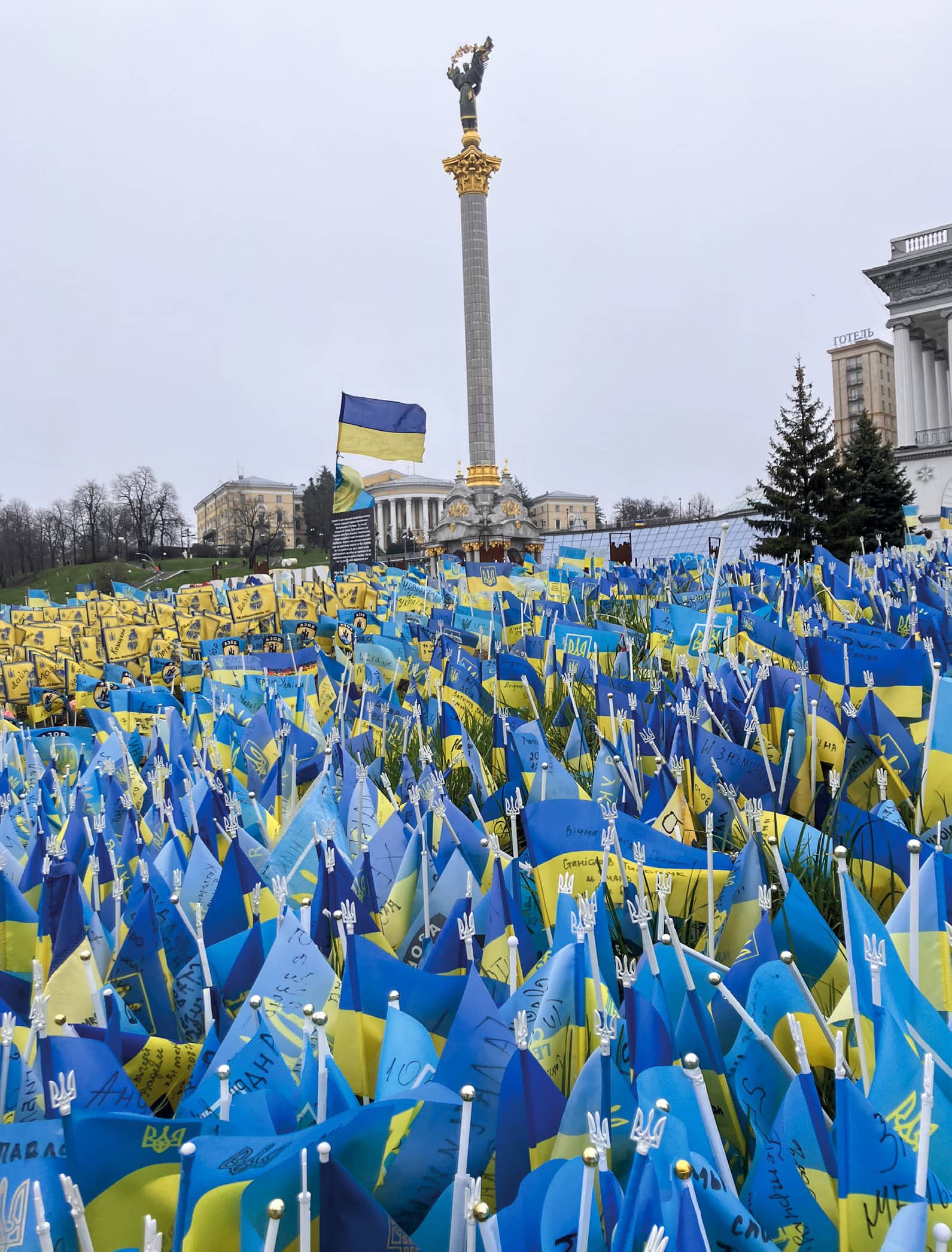
Maidan Nezalezhnosti, Independence Square: the Ukrainian flags in the grass mark the deaths of civilians in the conflict.
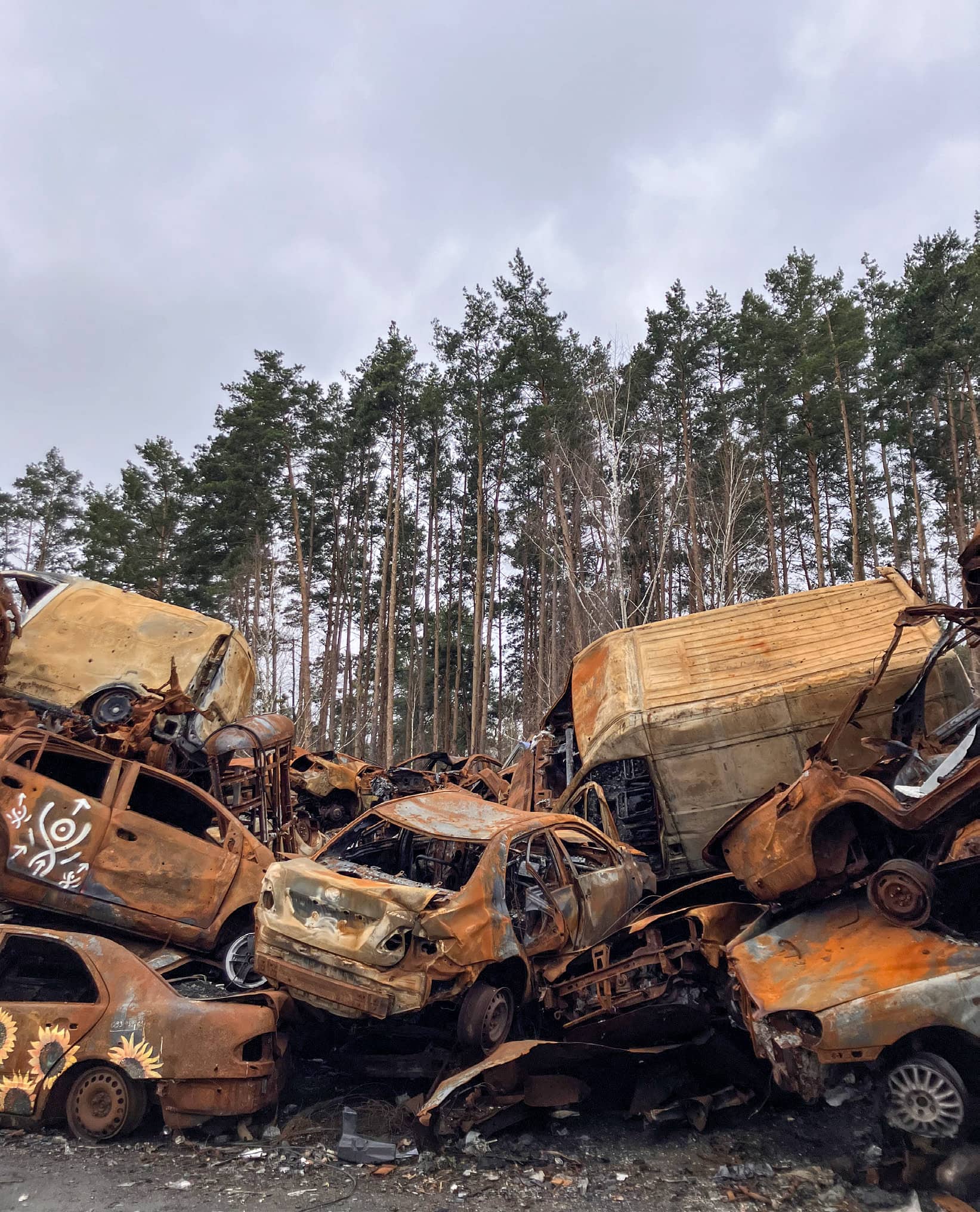
An unofficial memorial near Bucha.
Reflections on the study tour
Perhaps the main thing which will stick in my mind from this trip is the wonderful people we met. Unfortunately there is not the space to list them all here, but a few individuals must be mentioned. It was great to meet Igor Singer who wrote an article for the spring ARB Magazine (issue 200), and also Valentyn Skubak, founder of the Union of Arborists of Ukraine and one of the leading lights in the attempts to create an arboricultural profession from scratch. We enjoyed the company of arborists Sergij Rubets from Kharkiv and Andriy Lozinsky from Lviv, and Victor in Bucha. Olha and her colleagues are doing great work in the botanical garden, which was a pleasure to visit. Thanks are due to our local government hosts who were so supportive of the tour, including Oleksiy Korol, Oleksandr Vozny and Volodymyr Anfimov from the municipality of Kyiv. And of course Yana and Anna, who are doing incredible work with the Semen Oblomei Foundation and are turning tragedy into hope. It was also a privilege for me to spend those few days with the other members of the tour group – Piotr, Aleksandra, Renaldas and Kristina.
When visiting another country, spending time with people who care for trees, it always strikes me how the problems we all face are so similar. This is as true in Ukraine as anywhere else, albeit with a few obvious additional concerns at the current time. In every country there seems to be a lack of appreciation and acknowledgement of arboriculture. There is inevitably some regrettable pruning work, some less-than-ideal planting and often a lack of communication between government, arboricultural professionals, other disciplines and members of the public. I have yet to find any country which has comprehensively solved all of these issues. Ukraine is at the start of its journey in arboriculture. At the moment there is no tree care profession to speak of, but there are many passionate and talented people who are keen to learn – and an international community which is willing to help. Ukraine is firmly part of that international community.
Hope
When I mentioned to friends and colleagues in the UK that I was travelling to Ukraine to talk about arboriculture, several of them suggested that surely the people there have bigger things to worry about at the moment. Why trees, and why now? I took the opportunity to ask that very question of some of the people I met, and they all answered in pretty much the same way. They said that even though the country is at war, it is essential that people get on with their lives and focus on day-to-day matters. And once the war is over – once Ukraine has won – they will need to rebuild, and they are determined that trees will play an important part in that rebuilding. Finally, trees represent hope – and hope is important right now, perhaps more than ever.
Close to Irpin and Bucha, amongst forests made inaccessible by landmines, is an unofficial memorial which will forever be seared into my memory: a mountain of rusted and ruined cars, piled high and abandoned to the elements. As the invaders encircled Kyiv and the residents tried to escape the devastation, the enemy soldiers opened fire on them. Every wrecked and bullet-ridden car had once been occupied by people who were killed as they fled a war they had not wanted to be a part of. Yet even amongst all of this horror, rising from behind the mausoleum of twisted steel, the trees reach heavenward towards patches of blue in an overcast sky. And on some of the cars, graffiti has been painted – bright yellow sunflowers, the national flower of Ukraine and a symbol of peace. The winter has been long and harsh, but the buds are starting to burst and the forest is gradually turning green with new life. Spring is coming.
This article was taken from Issue 201 Summer 2023 of the ARB Magazine, which is available to view free to members by simply logging in to the website and viewing your profile area.